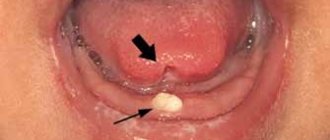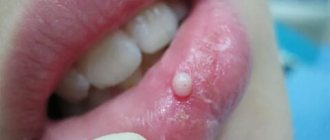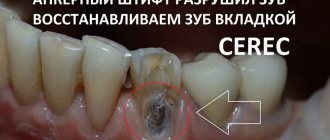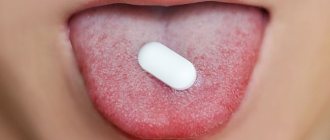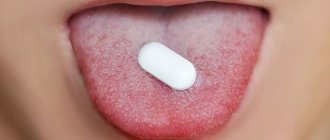Signs that your baby is teething
At the age of 3 to 8 months, the first symptoms associated with teething in children appear, these include:
- salivation increases;
- the child constantly puts hands or toys into his mouth;
- the gums swell and turn red;
- loss of appetite;
- the child cries a lot and behaves restlessly;
- the occurrence of vomiting, constipation or diarrhea;
- baby doesn't sleep well;
- cough and stuffy nose appears;
- diathesis develops.
Although teething in children under one year of age is a natural process, its symptoms resemble the development of some kind of disease. This is due to the fact that the tooth must break through the bone and gum before emerging.
What should parents be wary of?
Along with teething, an infection can join a weakened child’s body, so there are symptoms that require you to urgently show your baby to a doctor:
- if the child coughs very strongly and often with the release of a large amount of sputum, the cough is accompanied by wheezing and shortness of breath;
- when the baby has a profuse runny nose with the discharge of cloudy white or greenish mucus that does not go away for more than 3 days;
- the temperature during teething in children lasts more than 2 days, is not reduced by antipyretic drugs and is above 39 degrees;
- if diarrhea is very frequent and intense with mucus or blood;
- when constipation lasts more than 3 days.
In any case, if anxiety or unclear situations arise, it is better to consult a pediatrician. Since during this period the child’s immunity is weakened, he should be protected as much as possible from possible infection with infectious diseases, vaccinations and other medical procedures should be postponed.
What to do if your newborn doesn't eat formula well
A child who is artificially fed may also not be able to eat formula well. In addition to the above reasons why a baby refuses to eat, the following are possible:
The mixture is not selected correctly
If a child previously suckled at the breast and was switched to artificial feeding for some reason, then he may not eat because it simply doesn’t taste good to him. In this case, it is necessary to change the formula to a higher quality and nutritious one, for example, goat milk formulas have a pleasant creamy taste and therefore appeal to babies.
What should a mother do if the mixture is not suitable? Read this article.
Bottle or nipple does not fit
Some babies like anatomically shaped silicone nipples. Others find it easier to suck through traditional rubber ones. Pay attention to the diameter of the hole in the nipple through which the mixture pours. If it is large, then the mixture flows heavily and the baby chokes.
Gets full quickly
The baby can quickly suck and then push the bottle away. However, he does not scream or cry. That means he's already full. Try to feed according to the regimen indicated in the instructions for the mixture. High-quality infant formulas are more caloric and nutritious than breast milk, the fat content of which depends on many factors. Therefore, formula takes longer to digest, and the child may eat less often than on breastfeeding.
Sick
During illness, the baby does not eat formula well. You shouldn't force feed him. The baby's body needs time to fully recover.
According to the norm, a newborn should eat at least 90 ml of formula every 3-4 hours, then the amount of formula increases with age. If, despite all the measures, the baby does not eat well, refuses formula, or does not gain weight, then you need to contact a pediatrician to solve the problem.
Diagram of teething in children
If we talk about the order of teething in children, then everything is clear. The very first to cut are the two central incisors from below; they can emerge either in pairs or one after another. Then the central upper incisors erupt. The next ones are two lower and two upper side ones. Most children over one year old have four front teeth on top and bottom.
After the incisors, the canines erupt, but they give way to the molars, so there will be temporary gaps in their place. Then the canines and remaining molars grow. By the age of three years, the total number of teeth, including incisors, canines and molars, becomes twenty. There are no exact dates, everything is individual, this number of teeth can already be in two years. They begin to grow from the age of three months; if we take an average, this happens at eight months. It is believed that if the first tooth erupts later, then the loss of baby teeth will begin later. It is important to know that before reaching the age of one, the baby must have at least one tooth, otherwise it is worth examining the child for the presence of rickets, hyperthyroidism and other diseases.
Often the first tooth grows in pairs, and this can happen with the others; it happens that 4 teeth are cut at once. Of course, in this case, the eruption time is reduced. The order in which teeth appear may also differ, but don’t worry, everything in this case is very individual and goes according to nature’s plan.
How to help your child when he is teething
Infants are very sensitive to the behavior of their parents, so it is important to remain calm and pay as much attention to the baby as possible: carry them in your arms, distract them with toys, avoid quarrels. Breastfed babies will more often ask for the breast as it calms them down, it is important not to deny him this. During the growth of the baby's teeth, it is recommended to give teethers, which are made of safe materials and can alleviate his condition. Or it can be any toy that does not have small parts that can be chewed off.
You can also help your child with the following medications:
- Dantinorm baby
is a homeopathic remedy in the form of a solution that has a calming effect and relieves discomfort. - Dentokid
is a homeopathic remedy that relieves all unpleasant symptoms, including eating disorders, runny nose and fever. - Kamistad Baby Gel
– has an anti-inflammatory, regenerating and antiseptic effect thanks to lidocaine and chamomile, recommended for children over three months old. - Cholisal gel
– has an analgesic, anti-inflammatory and antimicrobial effect; it must be used with caution, as an allergic reaction is possible.
During the period when a child’s teeth are growing, it is difficult for both the baby and his parents. Children's crying and restless behavior accompanies this inevitable process. You just need to go through this period, supporting the child as much as possible and perceiving this as another stage of growing up.
This article is for informational purposes only, please consult your doctor for details!
Causes of poor appetite in a newborn
There may be several reasons why a baby does not eat well:
- breast problems;
- problems with milk (there is not enough milk or it flows too much or the taste of the milk has changed);
- bothers the tummy;
- teeth are being cut or an infection has appeared (stomatitis, thrush);
- sick or nervous;
- little one.
The mother’s task is to identify the cause and eliminate it. In difficult cases, you should consult a doctor.
Breast problems
A weak sucking reflex in a child occurs after a difficult natural birth, rapid with the application of forceps, or a cesarean section. Or if the baby was born prematurely, neurological symptoms are observed. To help your baby, teach him to “find the nipple.” To do this, grab the breast with your thumb and index finger. Lightly touch the nipple to the corner of the baby's mouth. If he does not react, then carefully place the nipple in his mouth yourself. Gradually, the baby will learn to find the breast on its own and begin to actively suck.
Incorrect attachment to the breast
A common problem especially among young mothers. To begin, choose a position that is comfortable for feeding. Breast and nipple shapes vary from person to person, so it’s important to choose one that suits both. Most often this is:
- On the side. The most common feeding position.
- Sitting. The child is in his arms or on a pillow.
- Football player pose. The mother is sitting, but the baby's head is brought to the side of the chest.
- On the stomach. Mom lies on her back, baby on her stomach. This “belly to stomach” position is good for colic.
Important!
The breast should not put pressure on the baby's nose. If he has difficulty breathing, he will not be able to suck properly. Feeding positions need to be changed periodically. This way, all lobes of the mammary glands are emptied, and congestion does not occur.
Inverted nipple
Almost flat, inverted nipples do not allow the child to suck and eat normally. The problem can be solved using feeding pads. Or you can express milk and feed your baby.
Please note that the full readiness of the mother's breasts for feeding is formed in the first months of the baby's life. The most difficult moment is the first minutes of sucking. Gradually, the milk ducts become wider and milk flows out of the breast easily.
If in the maternity hospital a child is used to eating from a bottle, then it is difficult for him to start breastfeeding. Don’t despair, be patient and persistent, because breast milk is the healthiest for your baby. Put your baby to your breast more often and he will quickly adapt.
Problems with milk
If the baby does not eat enough because there is not enough milk, then it is necessary to establish lactation. Mom should drink more warm liquids and lactogenic mixtures. It is recommended to sleep with the baby and ensure skin-to-skin contact.
If you still don’t have enough milk, you can supplement with formula milk. For supplementary feeding, it is better to choose a high-quality milk formula based on goat's milk, which will be as close as possible to breast milk. In this case, Kabrita goat milk infant formula is perfect.
But before supplementary feeding, give the baby one breast, then the other. And if you see that he is not full, then feed him with the mixture.
When there is a lot of milk, a strong stream hits the baby’s mouth, he chokes and does not want to eat. To reduce the intensity of the stream, you need to express the milk a little before starting feeding. If the mother has eaten spicy, salty or sour foods, or drunk alcohol, then the milk acquires a characteristic taste that is unpleasant to the baby. If the usual taste of milk has changed, then you need to carefully monitor your diet.
I have a stomachache
The baby willingly takes the breast and sucks. But after two or three minutes he breaks away from his chest and screams, arching his body. This symptom signals infantile colic. An infusion of dill water, applying a warm diaper to the tummy, gas tubes (for example, Windi brand tubes with a safe input limiter) or medications, but only as prescribed by a doctor, will help cope with the attack!
Dental problems
If teeth are being cut, the baby does not eat well and experiences pain in the gums when sucking. To reduce it, before starting feeding, you need to lubricate the gums with baby teething gel (for example, Dentinale natura).
Infection in the mouth
With thrush or stomatitis, small whitish spots appear in the mouth. Over time they increase in diameter. The mucous membrane is irritated and has a bright red color. The child does not eat well because he is in pain. To reduce the manifestations of stomatitis, after feeding, you need to treat the baby’s mouth and mother’s breast with a soda solution.
How to prepare: for 200 ml of water boiled at room temperature, take 1 tsp. baking soda. Stir until completely dissolved. Next, dip a gauze swab into the solution and wipe the inside of the baby’s mouth. Also treat the nipples. If your temperature rises, you should consult your pediatrician without delay.
Got sick
The baby is clearly hungry, but quickly abandons the breast, screaming. Check how your baby's nose breathes. Freely or with difficulty, sniffles heavily. If the nose is stuffy, it is difficult for the baby to suckle at the breast. To clear your nose, use a special aspirator (the NoseFrida aspirator is an excellent option), it is sold at any pharmacy.
Ears hurt
If your baby has ear pain, it becomes more intense when sucking and swallowing. To check whether the ears hurt or is it something else, you need to lightly press the tragus while feeding.
If there are problems with the ears, the baby will arch and scream loudly. In this case, it is better to express the milk and feed the baby with a spoon, a little at a time. For treatment of ears, consult a doctor. Don't self-medicate!
Child in a bad mood
For example, his mother did not come to him after waking up, and he burst into tears. Therefore, he can throw up his chest and cry loudly, hysterically. Don't panic. You need to calm the baby down with a pacifier and gentle rocking. Once he has stopped crying, you can give the breast. If he refuses, then give him a pacifier and put him in the crib for five minutes. Usually after this the baby completely calms down and eats willingly.
Maloyezhka
Sometimes a baby doesn't eat well because he or she is born with a dislike for eating a lot. He only needs a little milk and is also gaining weight slowly. If there are no developmental deviations, he is calm and active, then this is a physiological feature of your baby. In this case, there is no need to worry.
